NURS 6512 Assessing the Head Eyes Ears Nose and Throat Case Study Assignment Example
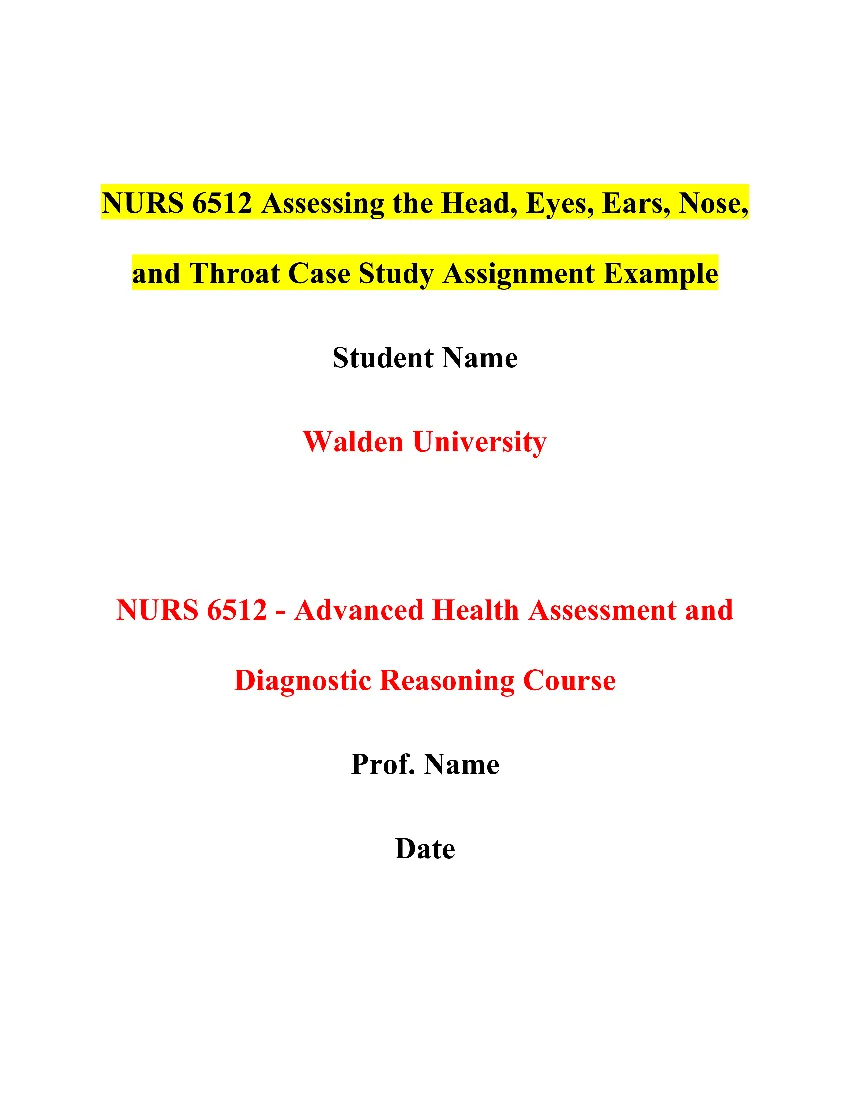 NURS 6512 Assessing the Head, Eyes, Ears, Nose, and Throat Case Study Assignment
NURS 6512 Assessing the Head, Eyes, Ears, Nose, and Throat Case Study Assignment
NURS 6512 Assessing the Head Eyes Ears Nose and Throat Case Study Assignment Brief
Course: NURS 6512 – Advanced Health Assessment and Diagnostic Reasoning
Assignment Title: NURS 6512 Assessing the Head, Eyes, Ears, Nose, and Throat Case Study Assignment
Assignment Instructions Overview
In this assignment, you will engage in a case study focusing on assessing conditions related to the head, eyes, ears, nose, and throat (HEENT). The goal is to apply clinical reasoning skills to differentiate between benign and potentially life-threatening conditions, thereby determining appropriate diagnostic tests and differential diagnoses.
For top-quality coursework writing help and assignment writing services, trust Nursing Custom Writing. Our expert team delivers 100% original human-written work tailored to your needs. Contact us via phone, WhatsApp, or live chat for assistance today and get the most reliable research paper help!
Understanding Assignment Objectives
The objective of this assignment is to simulate a clinical scenario where you will evaluate abnormal findings in patients presenting with HEENT issues. You will formulate an episodic/focused SOAP note, detailing the patient’s history, physical exams, diagnostic tests, and differential diagnoses based on evidence from the literature.
The Student’s Role
As a student, your role is to critically analyze the provided case study, identify pertinent patient data, and apply clinical assessment skills to recommend appropriate diagnostic procedures. You will demonstrate proficiency in constructing an episodic/focused SOAP note format, integrating findings from scholarly sources to support your clinical decisions.
Competencies Measured
This assignment measures competencies in clinical assessment, differential diagnosis formulation, evidence-based practice application, and effective communication through the episodic/focused SOAP note format. It evaluates your ability to integrate theoretical knowledge with practical clinical scenarios in the context of HEENT assessments.
You Can Also Check Other Related Assessments for the NURS 6512 – Advanced Health Assessment and Diagnostic Reasoning Course:
NURS 6512 Diversity and Health Assessments Discussion Assignment Example
NURS 6512 Differential Diagnosis for Skin Conditions Lab Assignment Example
NURS 6512 Building a Comprehensive Health History Discussion Assignment Example
NURS 6512 Assessment Tools and Diagnostic Tests in Adults and Children Assignment Example
NURS 6512 Assessing the Head Eyes Ears Nose and Throat Case Study Assignment Example
NURS 6512 – Case Study Assignment: Assessing the Head, Eyes, Ears, Nose, and Throat Episodic/Focused SOAP Note Template
Patient Information:
- Age/Gender/Race: 65-year-old African American male
- Chief Complaint (CC): Chest pain
History of Present Illness (HPI):
The patient, a 65-year-old African American male, presented with sudden onset crushing chest pain early in the morning, rated 9/10 in severity. The pain is located centrally in the chest and is accompanied by shortness of breath and nausea. Despite taking antacids, the symptoms have not significantly improved. The patient has a history of GERD and well-controlled hypertension. Family history includes the mother’s death at 78 due to breast cancer and the father’s death at 75 due to CVA. There is no known premature cardiac disease in immediate family members. Socially, the patient consumes moderate alcohol and does not use tobacco.
Review of Systems (ROS):
- General: Denies fever, chills, or fatigue.
- Cardiovascular: No orthopnea; positive for sporadic lower extremity edema.
- Gastrointestinal: Positive for nausea without vomiting.
Objective (O):
- Vital Signs (VS): BP 186/102 mmHg, P 94 bpm, R 22 bpm, T 97.8°F, O2 saturation 96%, Weight 235 lbs, Height 70 inches.
- Physical Exam:
- Cardiovascular: Diaphoretic and restless, PMI in 5th intercostal space at mid-clavicular line, grade 2/6 systolic decrescendo murmur at 2nd right intercostal space radiating to neck, third heart sound at apex, bilateral 2+ lower extremity edema.
- Abdominal: No distention or masses, normal bowel sounds, bruit in right paraumbilical area, mid-epigastric tenderness on deep palpation.
- Diagnostic Results: EKG, CXR, CK-MB tests conducted.
Assessment (A):
Differential Diagnoses:
- GERD (Gastroesophageal Reflux Disease): Chronic acid reflux causing chest pain.
- Hypertrophic Cardiomyopathy: Thickening of the heart muscle leading to chest pain, shortness of breath, and potential murmurs.
- Myocardial Ischemia: Reduced blood flow to the heart causing oxygen deprivation, resulting in chest pain and dyspnea.
- Pulmonary Embolism: Blockage of pulmonary arteries by blood clots, leading to chest pain and shortness of breath.
- COPD (Chronic Obstructive Pulmonary Disease): Chronic lung disease causing airflow obstruction, chest discomfort, and dyspnea.
Plan (P):
- Further diagnostics: Recommend continuation of EKG monitoring, CXR review, and CK-MB analysis to assess cardiac function and rule out pulmonary issues.
- Management: Initiate treatment for suspected conditions based on diagnostic findings, including potential adjustments to antacid therapy and consideration of cardiac medications.
- Referral: Consult with cardiology for comprehensive evaluation and management of suspected cardiovascular conditions.
- Patient education: Provide guidance on lifestyle modifications to manage GERD symptoms and hypertension, including dietary changes and stress reduction techniques.
References
Balogh E, Miller B, Ball J. The Diagnostic Process. Retrieved from [source].
Chamley R, Holdsworth D, Rajappan K, Nicol E. ECG interpretation. European Heart Journal, 40(32), 2663-2666. doi: 10.1093/eurheartj/ehz559
Haber J et al. Putting the Mouth Back in the Head: HEENT to HEENOT. Am J Public Health, 105(3), 437-441. doi: 10.2105/ajph.2014.302495
Heusch G. Myocardial Ischemia. Circ Res, 119(2), 194-196. doi: 10.1161/circresaha.116.308925
Marian A, Braunwald E. Hypertrophic Cardiomyopathy. Circ Res, 121(7), 749-770. doi: 10.1161/circresaha.117.311059
Qureshi H, Sharafkhaneh A, Hanania N. Chronic obstructive pulmonary disease exacerbations: latest evidence and clinical implications. Ther Adv Chronic Dis, 5(5), 212-227. doi: 10.1177/2040622314532862
Detailed Assessment Instructions for the NURS 6512 Assessing the Head Eyes Ears Nose and Throat Case Study Assignment
Assignment 1: Case Study Assignment: Assessing the Head, Eyes, Ears, Nose, and Throat
Most ear, nose, and throat conditions that arise in non-critical care settings are minor in nature. However, subtle symptoms can sometimes escalate into life-threatening conditions that require prompt assessment and treatment.
Nurses conducting assessments of the ears, nose, and throat must be able to identify the small differences between life-threatening conditions and benign ones. For instance, if a patient with a sore throat and a runny nose also has inflamed lymph nodes, the inflammation is probably due to the pathogen causing the sore throat rather than a case of throat cancer. With this knowledge and a sufficient patient health history, a nurse would not need to escalate the assessment to a biopsy or an MRI of the lymph nodes but would probably perform a simple strep test.
In this Case Study Assignment, you consider case studies of abnormal findings from patients in a clinical setting. You determine what history should be collected from the patients, what physical exams and diagnostic tests should be conducted, and formulate a differential diagnosis with several possible conditions.
To Prepare
- By Day 1 of this week, you will be assigned to a specific case study for this Case Study Assignment. Please see the “Course Announcements” section of the classroom for your assignment from your Instructor.
- Also, your Case Study Assignment should be in the Episodic/Focused SOAP Note format rather than the traditional narrative style format. Refer to Chapter 2 of the Sullivan text and the Episodic/Focused SOAP Template in the Week 5 Learning Resources for guidance. Remember that all Episodic/Focused SOAP Notes have specific data included in every patient case.
With regard to the case study you were assigned:
- Review this week’s Learning Resources and consider the insights they provide.
- Consider what history would be necessary to collect from the patient.
- Consider what physical exams and diagnostic tests would be appropriate to gather more information about the patient’s condition. How would the results be used to make a diagnosis?
- Identify at least five possible conditions that may be considered in a differential diagnosis for the patient.
The Assignment
Use the Episodic/Focused SOAP Template and create an episodic/focused note about the patient in the case study to which you were assigned using the episodic/focused note template provided in the Week 5 resources. Provide evidence from the literature to support diagnostic tests that would be appropriate for each case. List five different possible conditions for the patient’s differential diagnosis and justify why you selected each.
By Day 6 of Week 5
Submit your Assignment.
Submission and Grading Information
To submit your completed Assignment for review and grading, do the following:
- Please save your Assignment using the naming convention “WK5Assgn1+last name+first initial.(extension)” as the name.
- Click the Week 5 Assignment 1 Rubric to review the Grading Criteria for the Assignment.
- Click the Week 5 Assignment 1 link. You will also be able to “View Rubric” for grading criteria from this area.
- Next, from the Attach File area, click on the Browse My Computer button. Find the document you saved as “WK5Assgn1+last name+first initial.(extension)” and click Open.
- If applicable: From the Plagiarism Tools area, click the checkbox for I agree to submit my paper(s) to the Global Reference Database.
- Click on the Submit button to complete your submission.
Grading Criteria
To access your rubric:
Week 5 Assignment 1 Rubric
Check Your Assignment Draft for Authenticity
To check your Assignment draft for authenticity:
Submit your Week 5 Assignment 1 draft and review the originality report.
Submit Your Assignment by Day 6 of Week 5
To participate in this Assignment:
Get The Best Nursing Paper Writing Service and Unlock Your Academic Success
Are you overwhelmed with complex nursing assignments, tight deadlines, or specific instructions that seem challenging to meet? Look no further – nursingcustomwriting.com is your go-to destination for all your nursing paper writing needs! Our expert nursing essay writers are dedicated to providing you with high-quality, original, and customized nursing papers that guarantee the best grades possible.
Why choose nursingcustomwriting.com?
- Professional Nursing Writers: Our team of professional writers specializes in nursing essay papers, ensuring your assignment is in the hands of experts who understand the writing of nursing topics.
- Affordable Prices: We understand the financial constraints of college students. Our online nursing papers are available at very cheap prices, making our services accessible to all. Whether you need assistance with nursing coursework writing, want to buy a nursing essay online, or are in search of reliable nursing assignment help, we’ve got you covered.
- Customized Nursing Paper Solutions: Whether you need assistance with a complex topic, have a tight deadline, or are seeking a guide on how to write your nursing assignment, we’ve got you covered. Our writers will tailor their approach to meet your specific needs.
- Originality Guaranteed: Say goodbye to plagiarized papers! Our writers will provide you with an outstanding nursing essay paper written from scratch, ensuring it adheres to any topic, deadline, and instructions you provide.
Save your time for what matters most and let nursingcustomwriting.com take care of your essay. Don’t settle for subpar papers or risk submitting plagiarized content. Choose the best nursing paper writing service today!
Unlock your academic success by trusting nursingcustomwriting.com – Your Partner in Excellence.


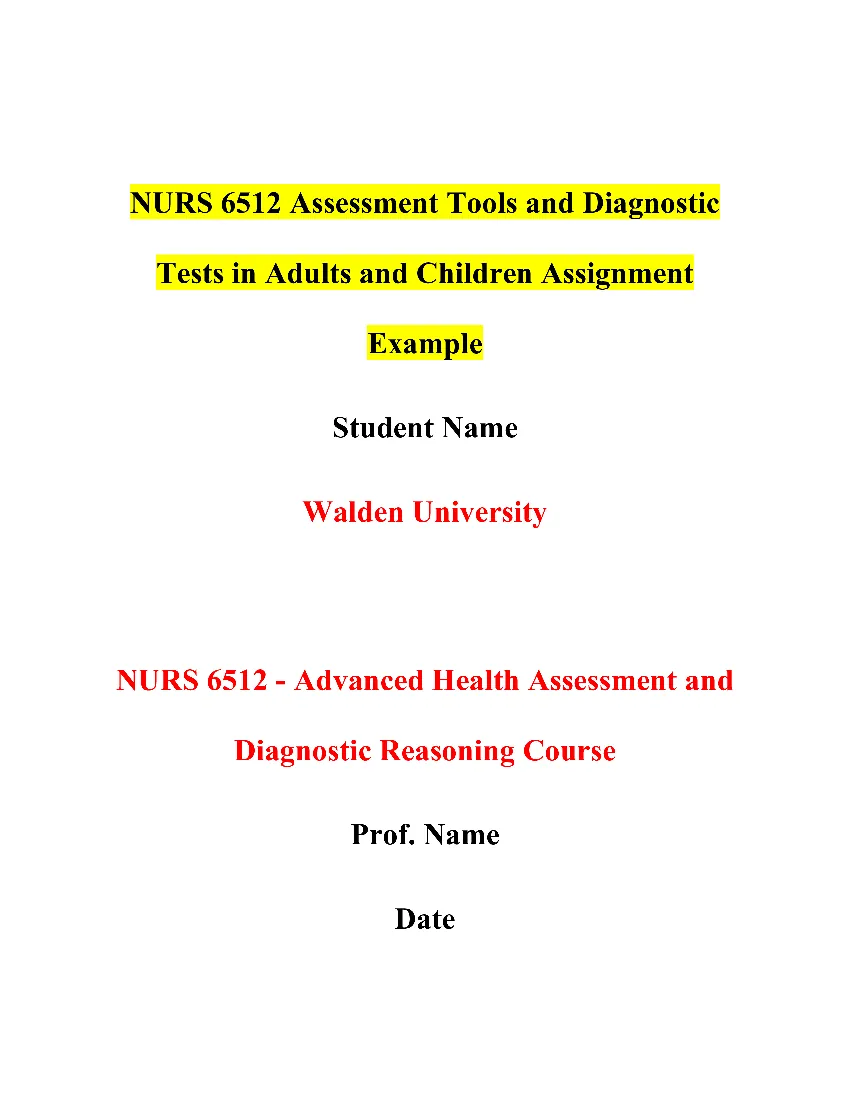 NURS 6512 Assessment Tools and Diagnostic Tests in Adults and Children Assignment
NURS 6512 Assessment Tools and Diagnostic Tests in Adults and Children Assignment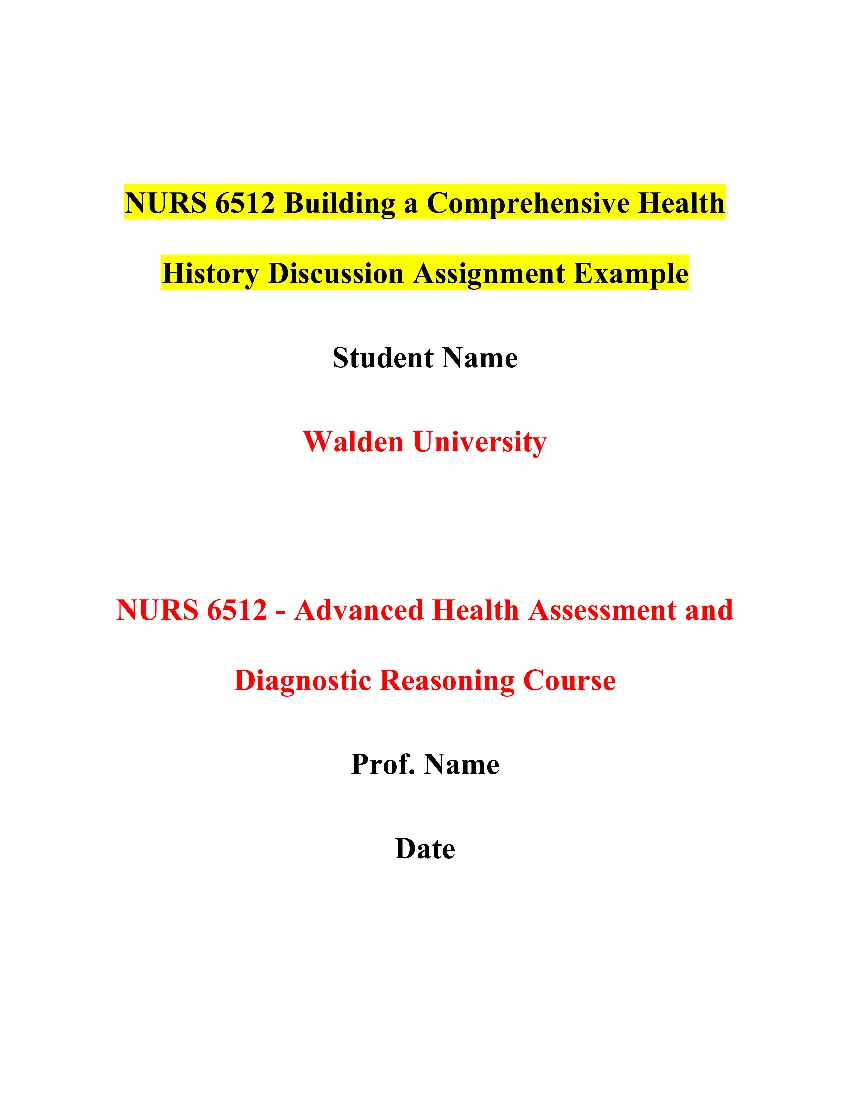 NURS 6512 Building a Comprehensive Health History Discussion Assignment
NURS 6512 Building a Comprehensive Health History Discussion Assignment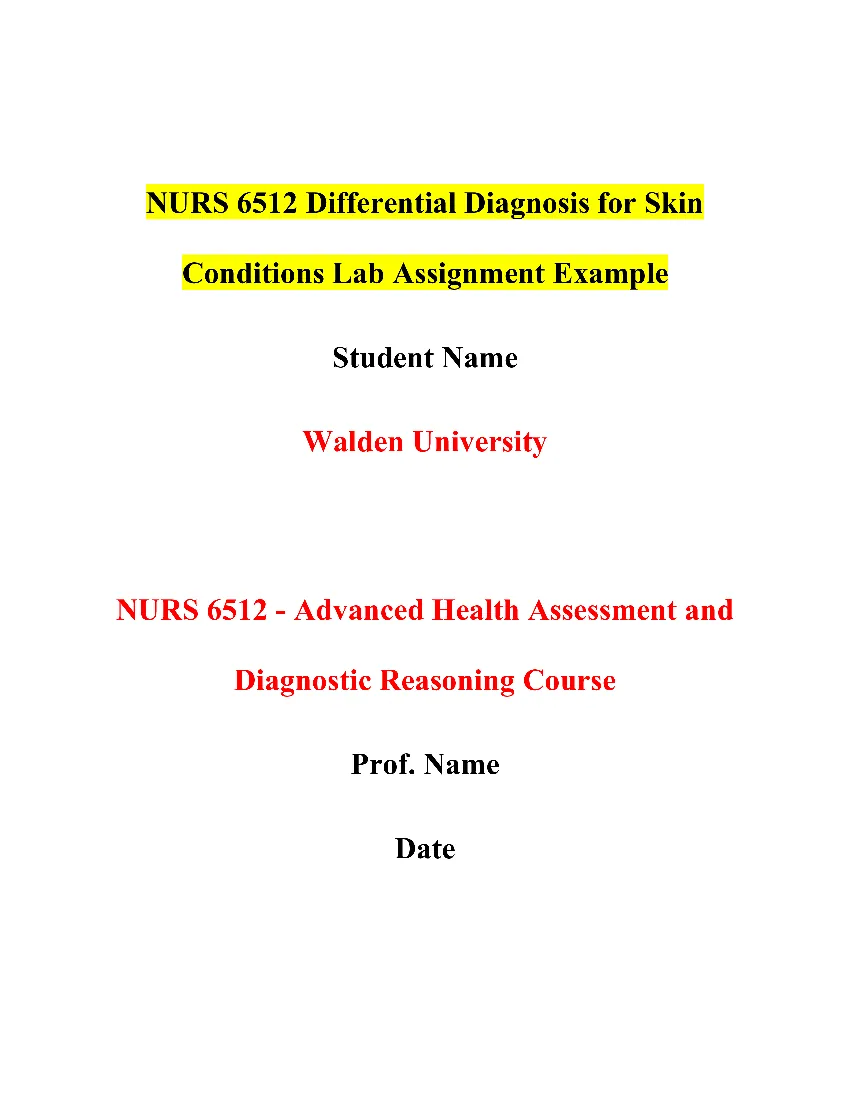 NURS 6512 Differential Diagnosis for Skin Conditions Lab Assignment
NURS 6512 Differential Diagnosis for Skin Conditions Lab Assignment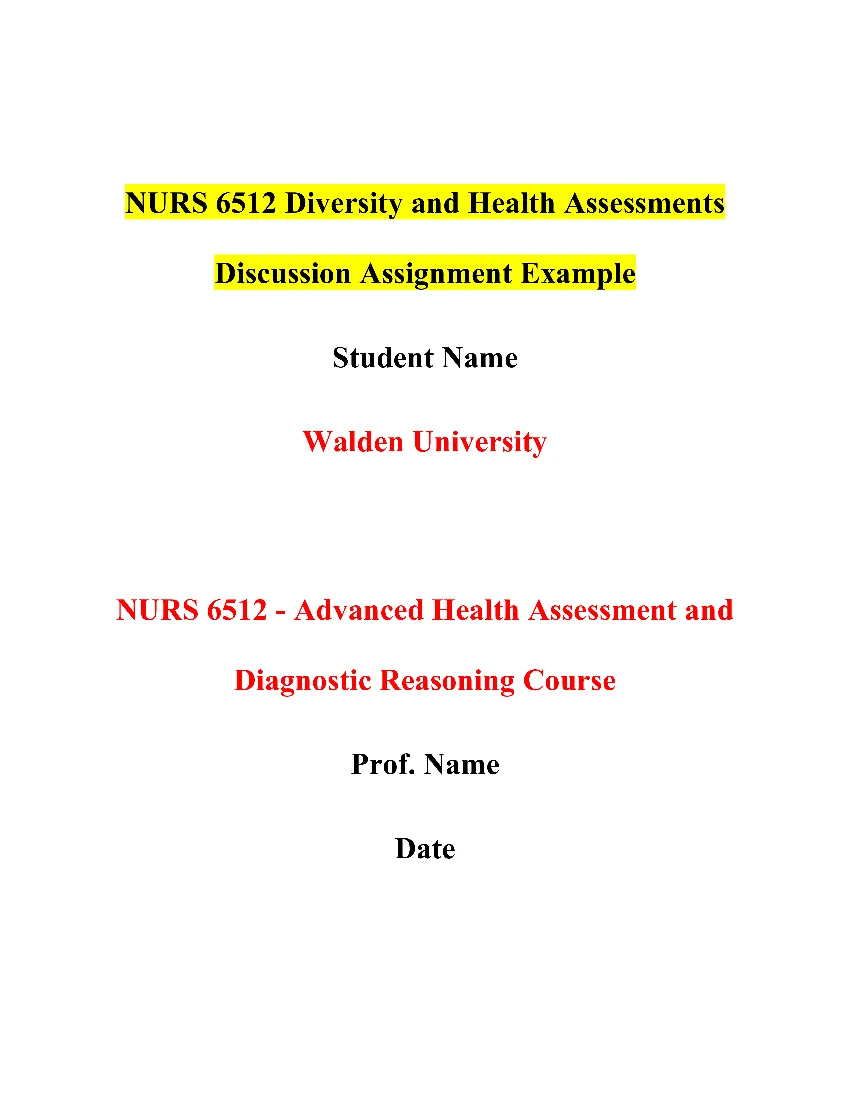 NURS 6512 Diversity and Health Assessments Discussion Assignment
NURS 6512 Diversity and Health Assessments Discussion Assignment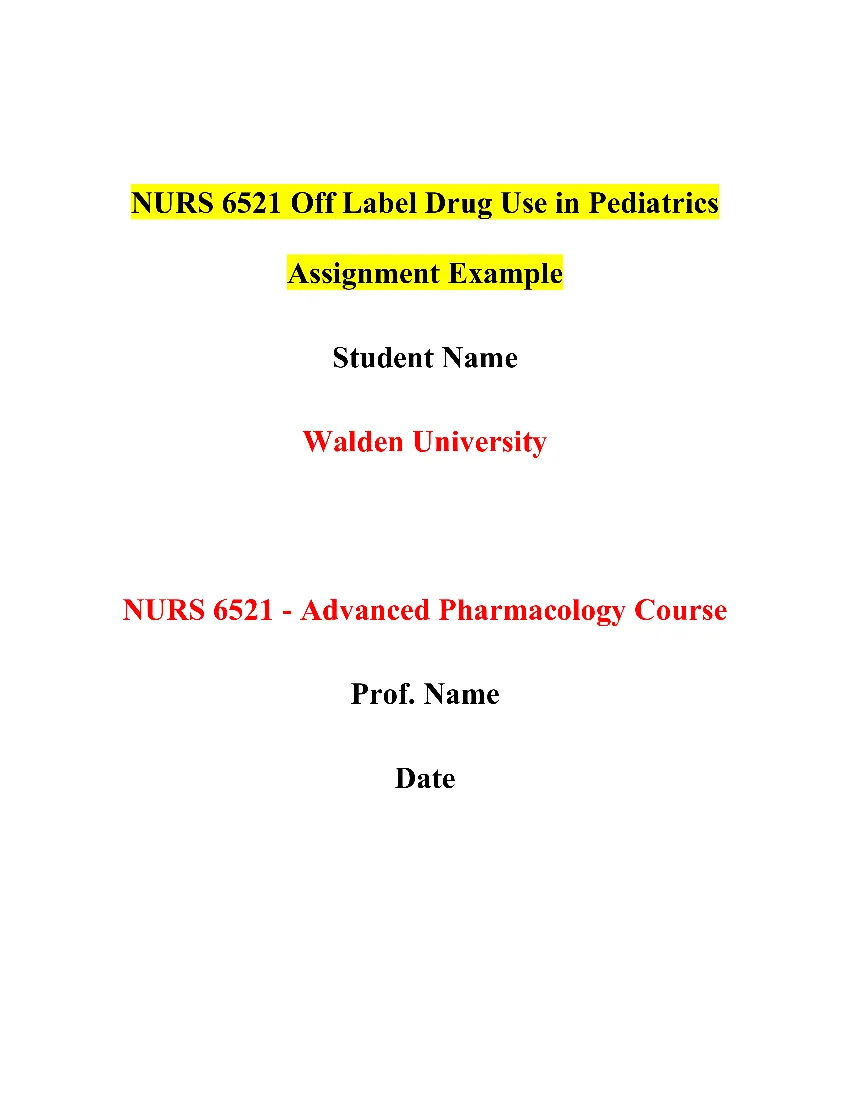 NURS 6521 Off-Label Drug Use in Pediatrics Assignment
NURS 6521 Off-Label Drug Use in Pediatrics Assignment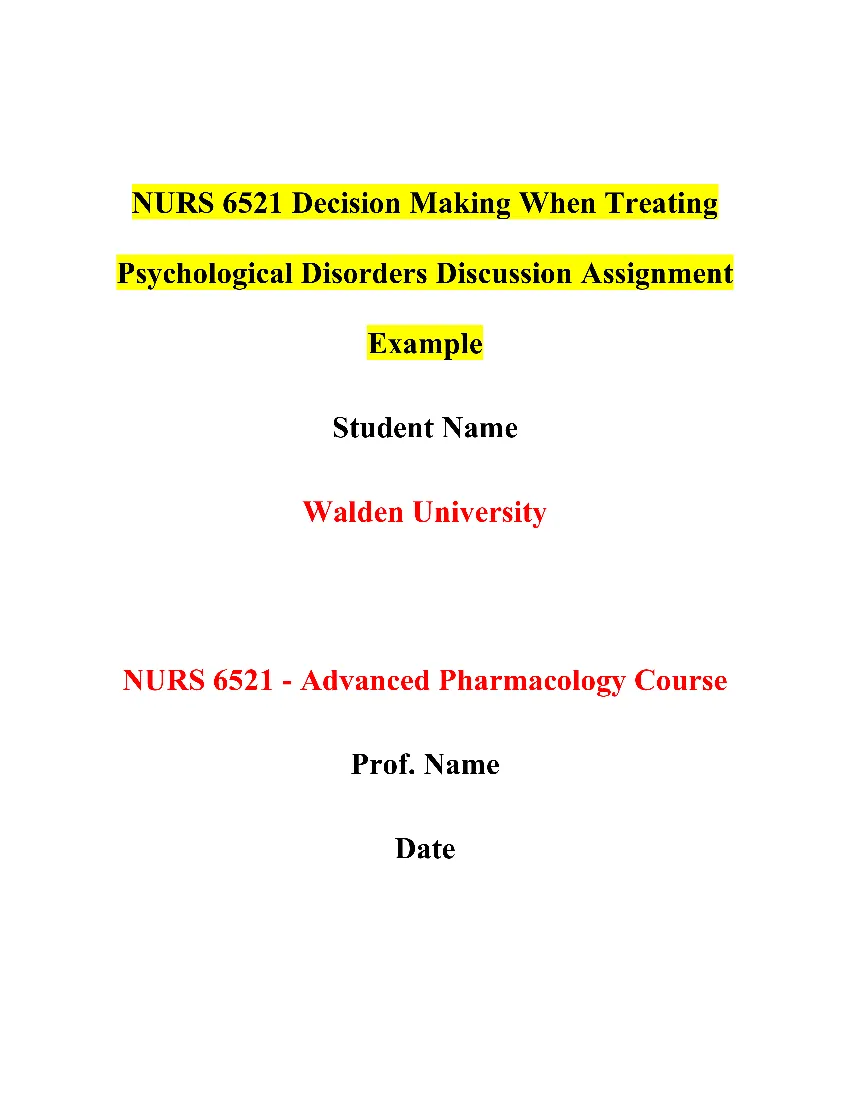 NURS 6521 Decision Making When Treating Psychological Disorders Discussion Assignment
NURS 6521 Decision Making When Treating Psychological Disorders Discussion Assignment NURS 6521 Decision Tree for Neurological and Musculoskeletal Disorders Assignment
NURS 6521 Decision Tree for Neurological and Musculoskeletal Disorders Assignment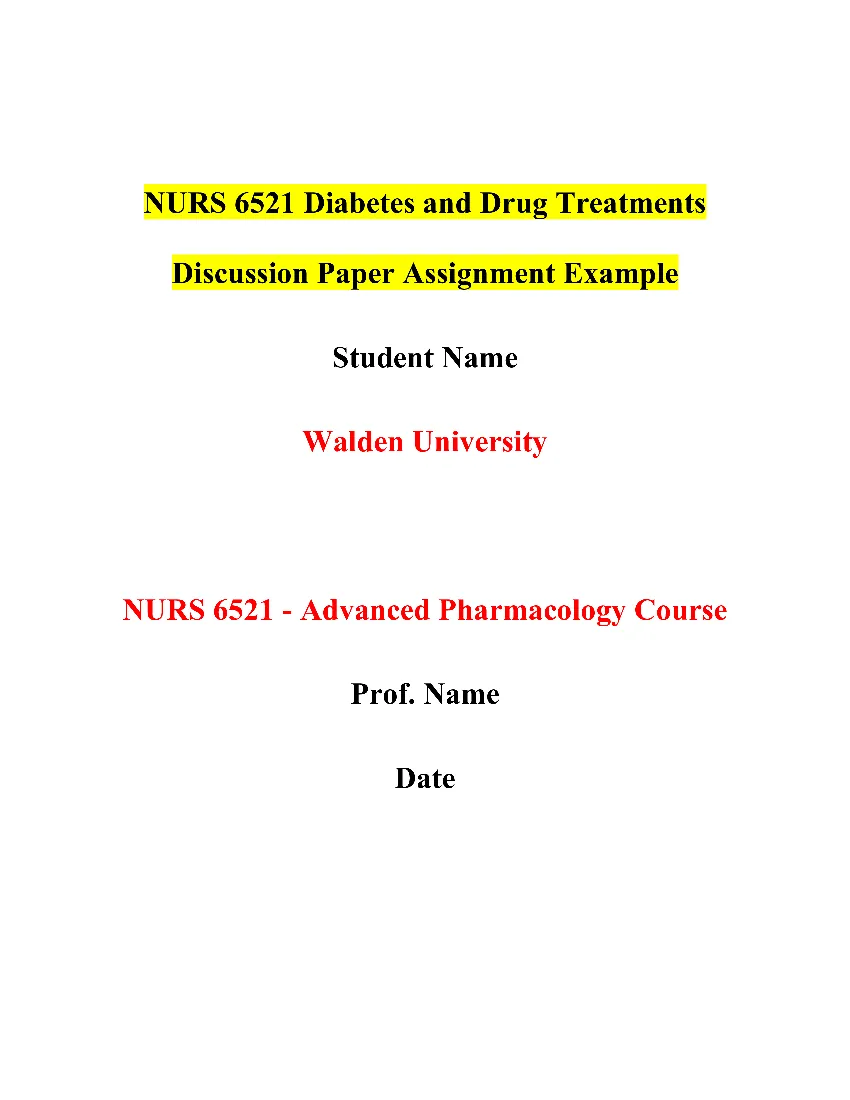 NURS 6521 Diabetes and Drug Treatments Discussion Paper Assignment
NURS 6521 Diabetes and Drug Treatments Discussion Paper Assignment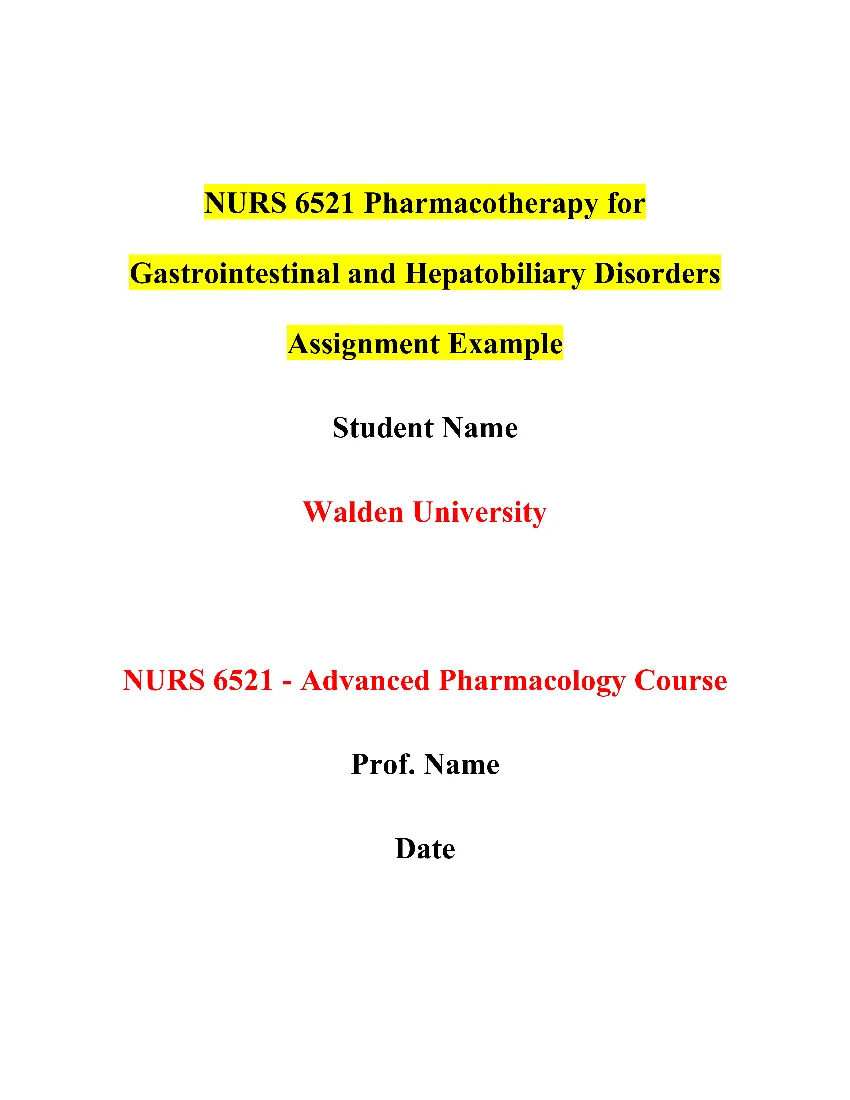 NURS 6521 Pharmacotherapy for Gastrointestinal and Hepatobiliary Disorders Assignment
NURS 6521 Pharmacotherapy for Gastrointestinal and Hepatobiliary Disorders Assignment